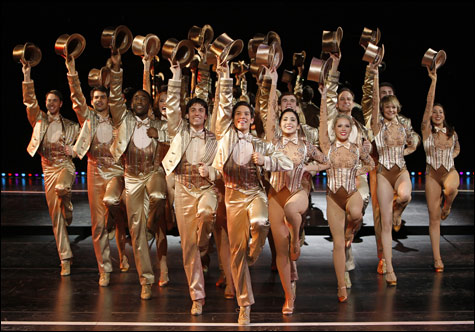
GOTTA SING, GOTTA . . . The gang's all there in the long-running musical. |
Admittedly, other musicals had to come before it for A Chorus Line to make any sense. But apart from that, the essence of musical theater is all there in this frisky colt of a theatrical warhorse. This exuberant paean to Broadway production numbers was born in 1975, yet nevertheless is timeless. It's at the Providence Performing Arts Center (through April 5), amply demonstrating why it will still be meaningful and absorbing to audiences generations ahead, holographic shimmering notwithstanding.The setup (and the set) couldn't be simpler: Nineteen dancers are auditioning for a handful of slots in an upcoming Broadway musical. The choreographer puts them through their paces, eliminating a batch right away and half of the survivors at the end. He asks them to talk about themselves, to get a sense of them as individuals before the final ax falls. Busby Berkeley production number, meet American Idol.
A Chorus Line boasts catchy music, witty songs, high kicks, and even higher drama now and then in stories of ambitious lives. What's not to like?
The music is by Marvin Hamlisch, with lyrics by Edward Kleban and book by James Kirkwood and Nicholas Dante. Of course, more credit than usual has to go to the original director, Michael Bennett, who co-choreographed with Bob Avian. After all, things could get tedious after repeatedly hearing the choreographer say "five, six, seven, eight" followed by the same routines. That's not so here, between the re-viewability of the snappy dancing and the drama of the unfolding stories.
These hard-working showfolk share backgrounds and traits in this group portrait. They are virtually a single, apprehensive colony animal, a wriggling sea anemone, as they sing the opening "I Hope I Can Get It" in hushed tones and are put through the paces of a dance number by the choreographer, Zach (Sebastian La Cause). The first solo is also typical, as the youngest of the hoofers, Mike (Clyde Alves), sings "I Can To That," conveying his joy at being able to effortlessly copy his sister's dance class steps at age four.
Likewise, in "At the Ballet," three of the women sing of falling in love with dancing after seeing the film The Red Balloon at impressionable ages. Something the troupe takes for granted was learned late by Val (Mindy Dougherty). In "Dance: 10; Looks: Three," she tells us how audition failure after failure, despite first-rate dancing, brought her to surgical enhancement and consequent success.
Their common experiences will sound as familiar in 2075 as they did in 1975. The only monologue that pops out and shrieks 1970s is that of shy, gay Paul (Kevin Santos), and only because it's given such prominence. As a 16-year-old high school dropout, the only good paying work he could get was in a 42nd Street drag show. It could be any decade, however, when he is discovered by his parents and feels reluctant shame.